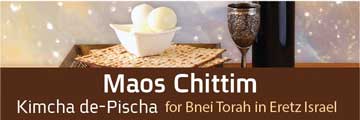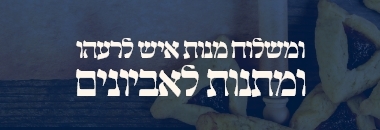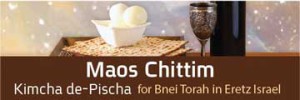In this week’s article, we will address the cosmetics question — do cosmetics require supervision for Pesach? Is wheat germ oil, or vitamin E oil, so commonly found in cosmetics, kosher for Pesach? When can cosmetics containing grain-derived alcohol be used? Is starch always derived from grains? Does soap need certification all year round? Is soap that contains animal fat permissible for use? Are we allowed to own on Pesach chometz food that is not fit to be eaten? Should chometz arts and crafts projects be discarded before Pesach? Why are we so strict with the halachos of Pesach, even more than with all year-round kashrus?.
Do Self-Care Products Need Kashrus for Pesach?
In this week’s article, we will address the question of which body care products require Pesach certification and kashrus for the whole year.
Background
Several ingredients commonly used in the cosmetics industry may contain chametz:
- Wheat germ oil.
- Wheat starch.
- Alcohol.
The wheatberry consists of three parts:
- The bran, primarily containing dietary fibers and B vitamins. This part is more difficult to digest, and eating it leads to slower and more thorough digestion. The bran makes up 13-17% of the wheatberry.
- The endosperm mostly contains starch and gluten [protein], and makes up 80-85% of the wheatberry.
- The lower part of the grain is the germ. If the grain is sown or sprouted, the germ is the part from which new wheat growth begins. The germ contains oil, known as wheat germ oil, and additional vitamins. The germ is 2-3% of the kernel.
To create chometz, we need two ingredients to work together: starch, which feeds the yeast and ferments, and gluten, which forms the network of strands that capture the air bubbles produced by the yeast, and allows the dough to rise. This is why natural leavening occurs only in grains that contain gluten [The five grain species that can become chometz].
Commercial white flour utilizes only the endosperm, since removal of the bran and germ produces a product with a longer shelf life (the bran and germ are prone to spoilage), as well as a softer and whiter product.
Whole grain breads use most, or all, of the wheatberry, which contains health benefits. Some mills grind the whole berry, while others remove only part of the kernel. Others, yet, create whole wheat flour by mixing white flour with bran and germ.
Since white wheat flour is produced in vast quantities, with the wheat germ removed to prevent spoilage, wheat germ is readily available at a relatively low price. The cosmetics industry takes advantage of it, and extracts wheat germ oil and vitamin E oil which are known to be highly beneficial for skin healing, repair, and nourishment.
Starch is used to thicken and or solidify soaps, shampoos, moisturizers and body creams. Lately, due to increased awareness of gluten sensitivity, wheat starches might be exchanged for gluten free alternatives.
Alcohol is another by-product of the wheat industry. Alcohol is created from the fermentation of carbohydrates. Whiskey is one example of a grain alcohol product, but not the only one. Other alcohols are also used in the cosmetics industry. While we have dealt with the use of alcohol on Pesach in previous articles, here we will focus on grain derivatives in the cosmetics industry on Pesach.
Kosher for Pesach Wheat Germ Oil
Rabbi Sinai Adler, the Rabbi of Ashdod, was asked to provide a Pesach kosher certification for the Revlon cosmetics factory. Revlon relied heavy on wheat germ oil, and it was necessary to determine the oil’s chometz status. To address this, he asked Rabbi Yosef Shalom Elyashiv to rule on the status of the oil. Rav Elyashiv permitted giving the factory a Pesach certification, even for products containing wheat germ oil, for the following reasons:
- The oil itself does not contain any starch, and cannot turn into chometz. [Rabbi Adler ensured there was not even a trace of starch in the oil].
- The oil production process involves cold pressing, without water or any solvents. Therefore, it is not expected to become chometz.
- Various additives are included, rendering the oil unfit for canine consumption.
Rav Elyashiv emphasized in his ruling that the permit is only based on the information he received, and not on observation or investigation.
How true are these facts today? Is wheat germ oil still extracted in the same manner? Apparently, Rav Elyashiv’s permit was based on the presumption that wheat germ oil is not expected to become chometz since it does not contain starch. Whereas we cannot pinpoint when wheat becomes chometz, or how the extracted oil may interact with different starches, contemporary poskim prohibit using all grain-based cosmetics or self-care products, even if they only contain non-chometz parts of the grain. Askenazim are even more stringent, and do not use any derivative of non-gluten grains or legumes (kitniyos).
Regarding the argument that the oil is no longer suitable for canine consumption, numerous poskim dispute this claim. Even Rav Elyashiv ruled leniently only because there was another reason to assume the product was not chometz. So, what type of chometz is considered unsuitable for canine consumption and permitted on Pesach?
Inedible Chometz
The Shulchan Aruch, (OC 442:9; Mishnah Brura thereon) rules that if leavened food became unfit for consumption before the sixth (seasonal) hour on Erev Pesach, and it is no longer fit for canine consumption, it need not be disposed of. The Torah only prohibited eating or owning chometz food, not inedible chometz. Furthermore, even if one decides to turn a large, edible lump of chometz into a chair, for example, and covers it entirely with paint or clay, the chometz is no longer considered food, and owning is it not prohibited. It is important to note that not only the designation of the chometz renders it a non-food item – it must also be covered entirely with inedible substances, such as clay or paint, before the last time for owning chometz passes. Painting or coating it after this time does not suffice to enable the owner to retain ownership of the chometz.
In light of this ruling, Rabbi Ben Tzion Aba Shaul rules (Volume III, Chapter 8, Responsa 7) that objects of “art” that contain wheat or barley coated in lacquer or paint may be kept over Pesach. However, they may not be consumed.
Not Eating Inedible Chometz
If retaining inedible chometz is permitted, why is eating it forbidden? If it is not considered chometz, why would eating it be prohibited?
The answer is based on a halachic concept called achshevey – while most people would not see it as important, an individual can make it significant for himself. An inedible object can have its status changed in to “food” if one decides to eat it.
The Taz (OC 442:8) and Mishna Brura (footnote 43) write that the prohibition of eating this sort of chometz is rabbinic, because it is no longer considered food. However, the Mishnah Berura (Sha’ar HaTziyun 442:72) writes that this applies only to food that has truly become unfit for a dog’s consumption, and a person eats it despite its taste. However, chometz that was fit for consumption, but covered with paint or lacquer regains its “food” and “chometz” status once the paint is scraped off in order to eat it. In this case, eating the chometz involves a Torah prohibition.
Eating Nullified Chometz
In one case, though, eating nullified chometz is not prohibited. The Shulchan Aruch mentions the example (442:10) of ink that contains beer, but is no longer edible due to the other added ingredients. The Shulchan Aruch rules that the ink can be used on Pesach.
The Mishna Brura explains that even should the writer mistakenly taste it while writing or chewing on the end of his pen, no transgression is involved, because the ink was not ingested for its flavor or nourishment.
Rav Nissim Karelitz (Chut Shani Pesach, Chapter 7, Footnote 3, p. 97), and Rabbi Ben Tzion Aba Shaul (Or LeTzion Volume III, Chapter 8, Footnote 6) drew from this halacha a similarity to toiletries such as mouthwash, lipstick, and toothpaste, concluding that they do not require a kashrus certificate as long as they are not fit for canine consumption.
Cosmetics
Our discussion of cosmetics assumes that all cosmetics are unfit for canine consumption, therefore, as we established earlier, even if the product contains wheat germ oil, starches, or grain-derived alcohol, owning it is permitted, albeit not eating it.
Here we meet with another, intriguing question – does the prohibition against using inedible chometz only prohibit eating it, or does it include all other uses and benefits? While the title of “chometz” as a food does not apply to inedible chometz, can it be used as a self-care product?
The poskim debate this issue. Some of those who prohibit it are the Shoel U’Meshiv (Volume I, Chapter 141); Maharam Schick (OC 242); Or Someiach (Responsa, Volume II, Chapter 55); while those who permit it are the Beis Meir (OC chapter 467); Yeshuos Yaakov (OC 442:7); Chazon Nachum (Chapter 46), and others. Even among those who permit it, many explain it is because the chometz is not being used for its main purpose, or since the chometz is nullified and now called something else. While the issue is widely debated, we will focus here on one opinion that explains why we must be more stringent with cosmetics.
Kosher Soap
To explain this issue, we will first explain the topic of kashrus for cosmetics. Do they require a hechsher all year round? Is rubbing non-kosher fish oil permitted if the oil is fit for canine consumption?
The Mishna (Shabbos 86a) states that anointing with oil on Yom Kippur is equivalent to drinking water. This is learned from the pasuk in Tehilim (109:18): “It came like water into his innards, like oil into his bones.” What is the nature of this prohibition?
Tosfos in Yoma (76b) writes that this halacha only applies to Yom Kippur, truma, and sacrificial offerings. For all other prohibitions no restriction is applicableHowever, elsewhere (Niddah 32b) the Tosfot explains that only non-kosher liquid oil is rabbinically forbidden, but solid non-kosher fats are not prohibited. Rabbenu Yerucham (Toldot, Chapter 27, page 136, column 4) explains that oil absorbs in the body, so the Sages equated it with drinking water, but solids are not equated with water.
The Magid Mishna (Halachos of Forbidden Foods, chapter 8, halacha 16) adds that anointing oil is considered eating less than the required amount to violate the prohibition (chatsei shiur) and forbidden because eating less than the required is still forbidden. The Machane Efraim adds that only if the oil is used for pleasure it is forbidden, but anointing to prevent pain is not considered akin to drinking.
On the other hand, the Sefer Hatruma (Shabbos 238), Mordechai (Shabbos 339), Orchos Chaim (Forbidden Foods 45) are of the opinion that the prohibition refers to all prohibited materials, liquid or solid alike, but our sages forbade only using them for pleasure. Applying them to prevent pain, such as to cure a wound or dry skin, and not for pleasure, and permitted.
Practically, the Taz (YD 117:4) permits anointing with all prohibited substances besides truma, or on Yom Kippur. The Shach (Nekudos Hakesef YD 117:2) offers insights into the aforementioned opinions, concluding that conventionally, we tend to adopt leniency concerning kosher animal fat (derived from the non-permitted parts of the animal) while forbidding pig fat. He suggests that this custom may serve to underscore our aversion to the pig and its impurity, or perhaps to foster a sense of separation from non-Jews who consume it. The Pri Chadash (YD 117:4) asserts that mainstream halacha aligns with those who permit it. On the other hand, the Vilna Gaon (OC 326:10) decrees that all forms of non-kosher fats, including saturated fats, are prohibited, although in cases of alleviating pain, the prohibition is waived.
The Mishna Brura (326:10) references the opinion of the Vilna Gaon but notes that the prevailing practice leans toward leniency, with only the most meticulous in observance being stringent. Nevertheless, where kosher soap is readily available, it is advisable to exercise caution and utilize it. The Aruch Hashulchan adds (YD 117:29) that since our soaps are inedible for dogs, their usage is evidently permissible.
Here comes the Pesach question: according to those opinions that equate anointing with drinking, and see it as forbidden, would anointing with chometz oil be akin to considering it as food and forbidden, just as eating chometz is forbidden despite being inedible?
Practical Ruling
Rav Nissim Karelitz (Chut Shani Pesach 7:3) and Rabbi Ben Tzion Aba Shaul (Or LeZion, Volume III, chapter 8:6) are of the opinion that anointing is not equal to drinking with inedible substances, therefore using inedible chometz oils is permitted, provided one does not eat it.
Rav Moshe Feinstein (Igros Moshe OC volume III, chapter 62) maintains that employing such products is permissible solely when their purpose is to remedy skin conditions or alleviate discomfort, but not for mere pleasure.
Scrupulous Pesach Preparations
Why are we more scrupulous with Pesach than with year-round kashrus? Shut Min Hashomayim (chapter 71) explains that it is because Pesach was the first mitzva that we received as a nation, which was accepted with love. Therefore, we are scrupulous with its rules and details. The Torah was also careful that no chometz be found in one’s property, unlike all other prohibited substances. One who is scrupulous with these halachos enjoys longer life and days.
The Zoahr writes (Ki Tetze 282b) that one who is scrupulous to avoid chometz on Pesach protects his body and soul from the Yetzer Hara and of him it is written: “For You are not a G-d Who desires wickedness; evil does not abide with You” (Tehilim 5:5) one who is careful to sanctify his body and soul, prevents the Yeter Hara from approaching him. And the Ari Hakadosh writes (Dvash Lefi, 8:18) that one who is careful to avoid consuming even a tiny amount of chometz on Pesach, is assisted from heaven not to sin all year long.










